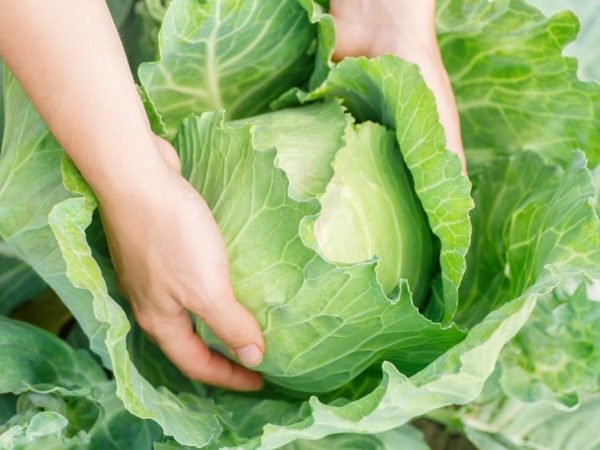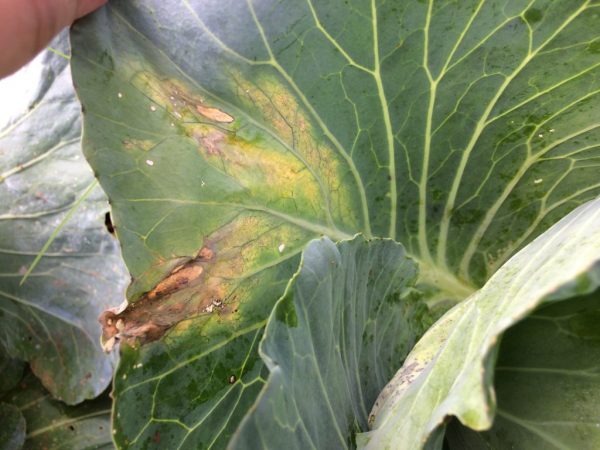Characteristics of the cabbage variety Valentine F1
White cabbage Valentine is a late hybrid that has gained popularity among gardeners in a short time. The variety was zoned in 2004 for the Central region of the Russian Federation.

Characteristics of the cabbage variety Valentine F1
Characteristics of the variety
Valentina F1 is a hybrid of late ripeness with large heads of cabbage that retain their taste for a long time. According to the characteristics, the ripening time of the variety is 140-170 days from the moment of germination. The culture easily tolerates a short drop in temperature and even a sharp cold snap.
The crop yield is about 700-800 tons per hectare. The germination capacity of cabbage is at least 90% of the total number of plantings, but an annual purchase of seed is required, because the hybrid does not repeat the properties of the parent varieties.
Description of the head
The head of cabbage has a characteristic structure:
- it is round, very dense, medium-large at the stage of technical ripeness;
- stump is white, the outer one is medium in size, the inner one is short;
- raised leaf type rosette;
- leaves are slightly wavy at the edges, covered with a pronounced waxy bloom.
The weight of a ripe head of cabbage averages 2.8-4 kg, ripening lasts until stable frosts. Cabbage is not prone to cracking and has a high level of transportability.
Application of the vegetable
Cabbage Valentina F1 has excellent taste that persists throughout the entire time (even after thawing). The excellent presentation of the hybrid is supported by a stable keeping quality - vegetables are stored from October (harvest time) to mid-spring, in some cases storage lasts up to 10 months.
The variety is perfect both for fresh consumption and for canning (winter salads, fermentation, etc.). It is preferable to use vegetables after several months of storage, when the residual bitterness leaves the leaves.
Care
Cabbage varieties Valentina are grown using seedlings according to the 70 x 40 scheme. The hybrid, like all late-ripening varieties, does not like thickening, therefore, the maximum planting density of 4 plants per 1 sq. M. Must not be exceeded. m. Ideal for cultivation are peat and loamy soils, which retain moisture well.
Cabbage Valentina F1 is light-requiring, therefore, for its cultivation, it is preferable to choose a flat surface with good illumination throughout the day. When planting, crop rotation should also be taken into account: you should not define seedlings in beds where there were other cruciferous plants before. It is best to choose places that have grown vegetables such as onions, potatoes, cucumbers or tomatoes.
The optimum air temperature for the culture is 15-19 ° C. Seedlings can withstand temperatures down to -3 ° C, adult bushes - up to -8 ° C. At temperatures above 30 °, Valentina F1 cabbage stops the formation of heads of cabbage and may even die.
After planting in open ground, the seedlings need standard care:
- systematic watering with warm water (they are carried out late in the evening or very early in the morning) and sprinkling;
- regular fertilization (three times during cultivation);
- timely weeding (weeds can be carriers of the disease or contain slugs);
- loosening the soil and hilling to strengthen the root system;
- preventive treatment against insect pests and various diseases.
Diseases

At the first signs of the disease, treatment is started
Culture is immune to many types of diseases:
- fusarium wilting (yellowness);
- black leg (rhizoctoniasis);
- black spot (alternaria);
- white and gray rot.
The hybrid is moderately resistant to keel - the most common and dangerous fungal disease of cabbage, radish, turnip, etc. This fungus is a problem for everyone who has ever planted crucifers. Until the moment of infection, spores can be in suspended animation for several decades.
Infection occurs with planting material and organic fertilizers (excessive moisture and acidity of the soil can contribute to this). Keela promotes the growth of neoplasms on the roots, blocking the movement of moisture in the root system, due to which the seedling quickly dies. After detecting the fungus, it is necessary to quickly disinfect the soil using slaked lime, get rid of weeds and burn the affected plants.
The greatest danger to the Valentines cabbage is represented by apical rot and pinpoint necrosis. The characteristic of these non-communicable diseases contains the features of the lesion and methods of dealing with them:
- Vertex rot is a disease provoked by the larvae of the cabbage fly. Its development is facilitated by an excess of fertilizers with a nitrogen content and a deficiency of calcium in the soil. When the plant is damaged by apical rot, a sharp dying off of the edges of the upper leaves of the cabbage occurs. If a disease is detected, the soil around the seedling is treated with tobacco dust and phosphate rock.
- Pinpoint necrosis occurs under conditions of improper care and storage. The disease is a cosmetic defect in the form of dark spots on the leaves, impairing the presentation of the vegetable. Necrosis is contagious, i.e. transmitted from one head of cabbage to another, therefore, if it is found, it is necessary to urgently destroy the affected vegetables.
Pests
The culture is affected by such pests:
- Cruciferous (cabbage) flea. She eats holes in the leaves, can eat them completely.
- Whitefish butterfly larvae. These pests are engaged in eating leaves throughout the day.
- Slug. It feeds at night and can cause extremely serious damage to more than half of the crop.
- Cabbage fly larvae. They spoil the root system.
- Caterpillars of the cabbage moth. They feed on the tissues of the leaves of the plant.
The fight is complicated by the fact that insects are usually difficult to find under the leaves or inside the head, so an important point of crop care is the regular inspection and manual collection of insects, their eggs and larvae.
Treatment with insecticides is also practiced (Aktellik, Karate, Bankol, Bi-58, Decis, hexochlorane solution) or folk remedies (vinegar solution, wormwood infusion, ash, tobacco dust, naphthalene, hot pepper decoction ).
Conclusion
Description of Valentine's cabbage reveals its strengths: high yield, good keeping quality, pleasant taste.
It is not difficult to plant cabbage and grow it, the main thing is to adhere to the basic recommendations for care and treat diseases in time.


